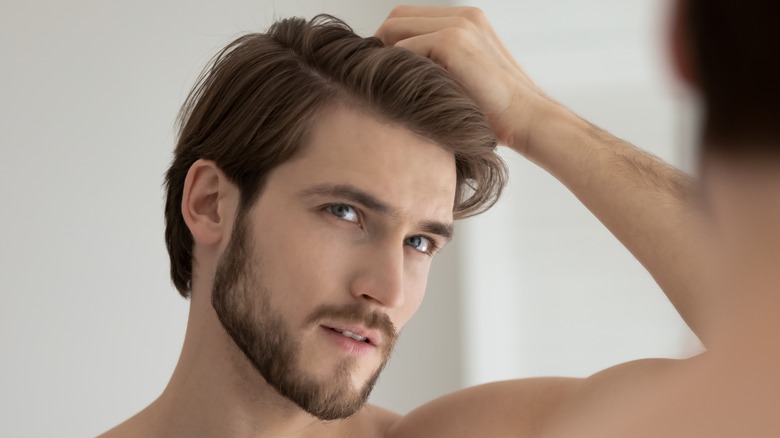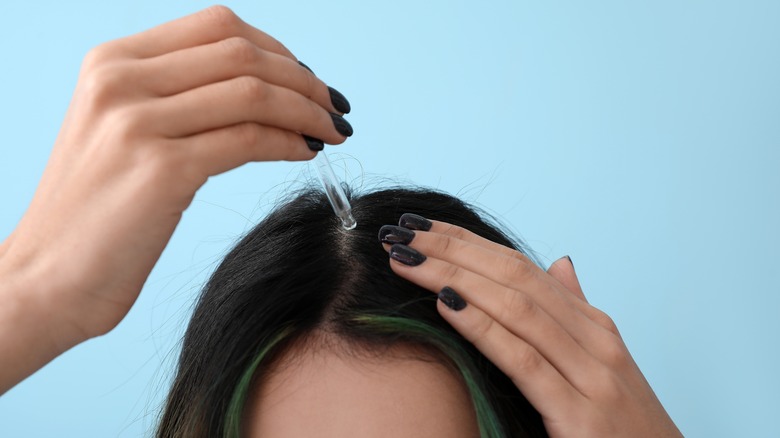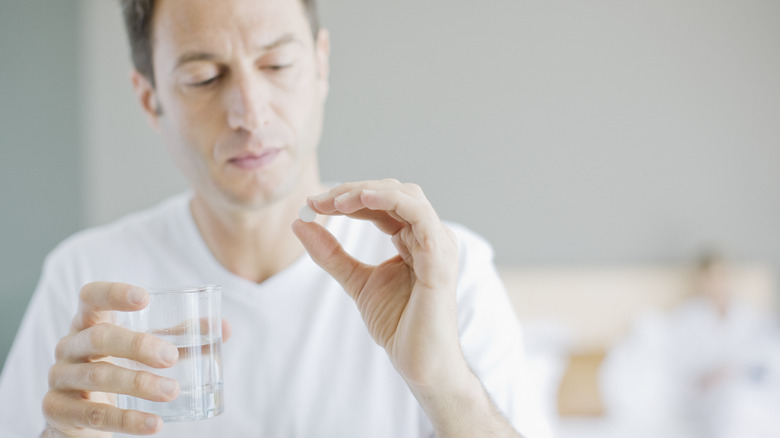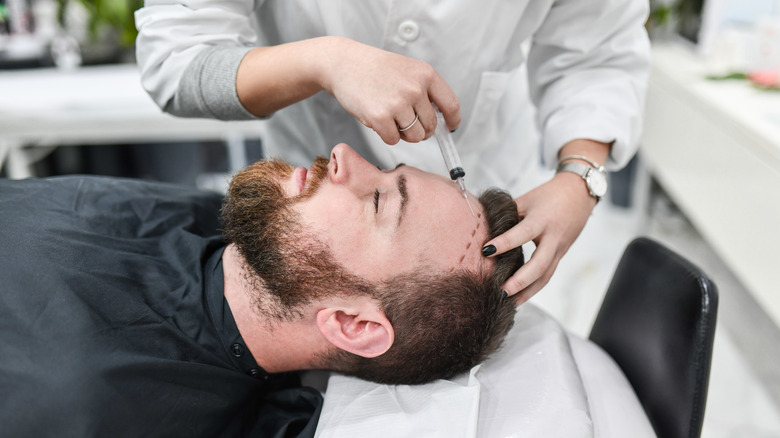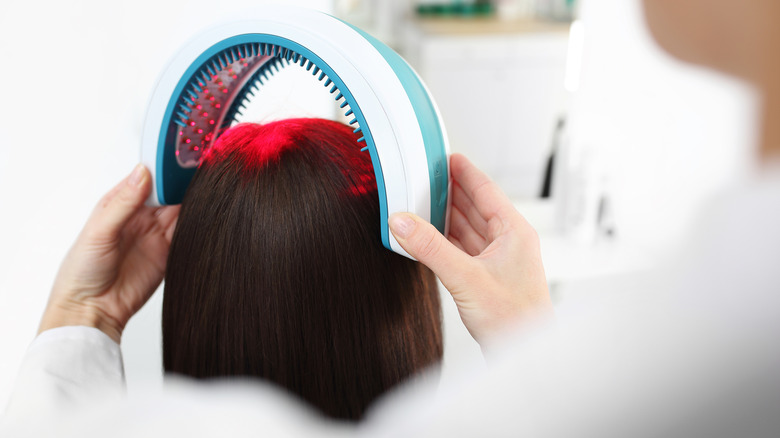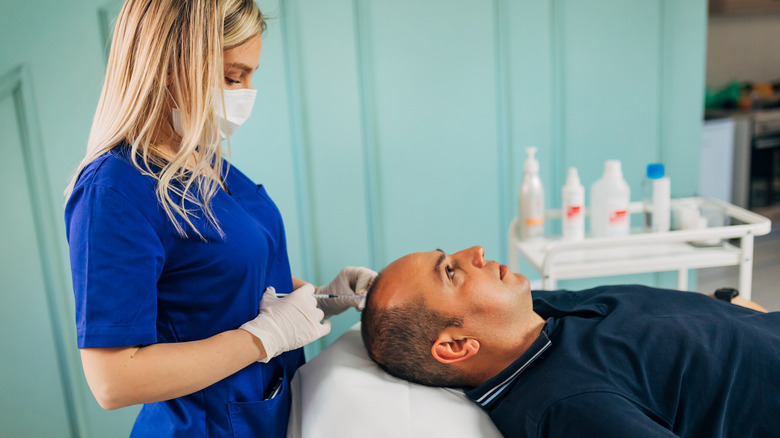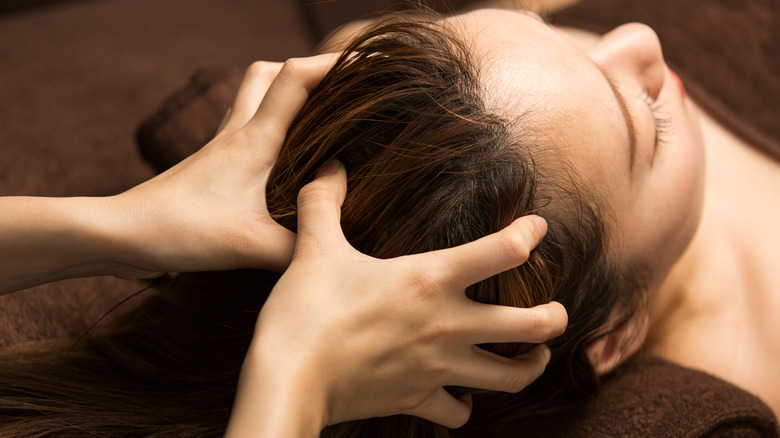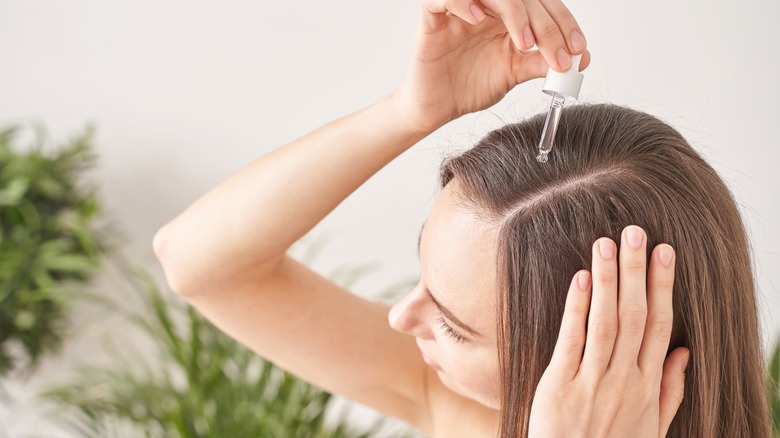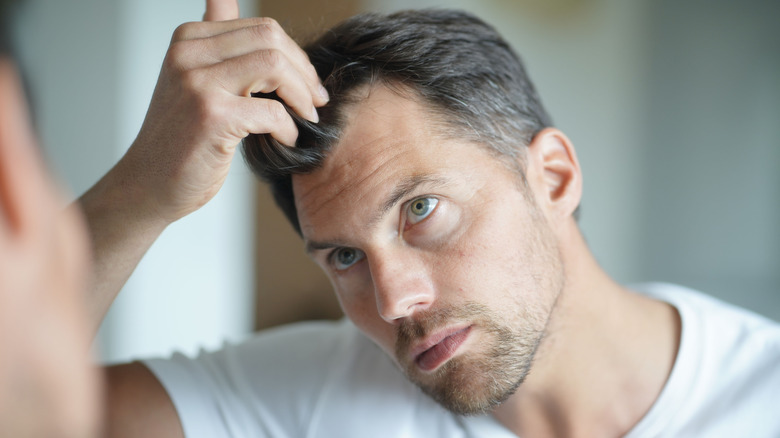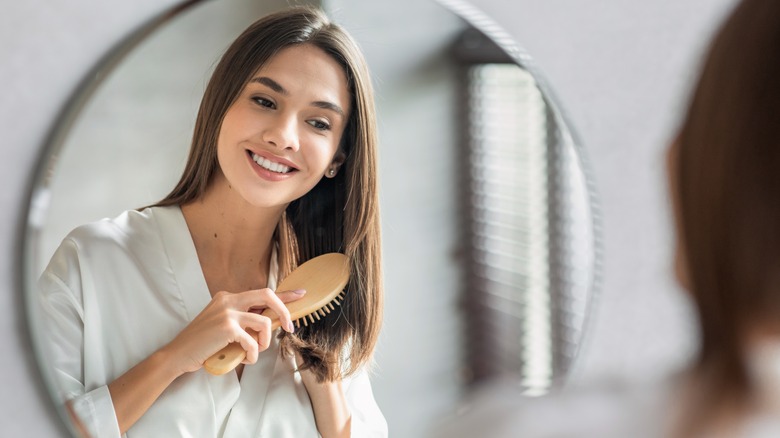How To Combat A Receding Hairline
Hair loss is a natural part of aging. Whether you notice thinning, bald spots, or your hairline slowly creeping back from your forehead, rest assured that you're not alone — more than 80 million Americans experience it (via Southeastern Plastic Surgery, P.A.). Male-pattern baldness — the most prevalent form of hair loss in men — typically starts with a receding hairline, with hair loss at the temples moving backward and making an M shape (via Penn Medicine). Women can also experience this condition, called female-pattern baldness. Another form of hair loss in women that causes a receding hairline is frontal fibrosing alopecia (via the Belgravia Centre), which primarily affects post-menopausal women. Traction alopecia, caused by styling that pulls on the hair, extensions, and relaxers can also cause a receding hairline in women.
A receding hairline is normal, but it can be damaging to your self-esteem. The good news is that there are many treatments for hair loss now that can restore at least some of your hair and help you keep the hair you still have. Topical medications, medical treatments, cosmetic procedures, scalp massage, and more, have all been shown to be effective. Lifestyle changes, such eating a healthy diet, can also help.
Visit your doctor
Before you can begin to treat hair loss, you need to know what's causing it. Your doctor is the best person to consult about this. Many factors can play a role in hair loss, including underlying health conditions and medications. Health conditions that can cause hair loss include lupus, syphilis, thyroid problems, hormone imbalance, and nutritional deficiencies (via Harvard Health Publishing). If you're experiencing any physical symptoms along with hair loss, this can be a sign that it's not just a common receding hairline. In this case, your doctor may decide to run tests, such as a blood panel. Medications, including warfarin, lithium, beta-blockers, heparin, and levodopa, can also cause hair loss. Typically, health conditions and medications will cause diffuse hair loss, not only a receding hairline, but it's still a good idea to rule them out as a cause.
If a medical condition or medication is not the problem, your doctor may refer you to a dermatologist who will look at your scalp for any signs of inflammation, scarring, sores, or redness. In women, frontal fibrosing alopecia often leaves telltale marks on the scalp, including pale skin, scarring, and inflammation surrounding the hair follicles (via the Belgravia Centre). A dermatologist can also conduct tests to gauge the pattern and severity of hair loss and the condition of your hair's health. These include pull and tug tests, card test, fungal culture, trichometric analysis, punch bioposy, and blood tests (via NYU Langone Health).
Use topical medications
One of the most common treatments for a receding hairline is the topical medication Monoxidil, which works by reducing the duration of the telogen phase — the resting phase of hair growth — thereby increasing the speed at which the hair begins the growth phase (via Hairclub). As a vasodilator, it helps expand the blood vessels, which enables the delivery of greater amounts of oxygenated blood to the hair follicles. Minoxidil may also improve the thickness and strength of hair by enlarging the hair follicles.
Minoxidil comes in different strengths — 2% and 5%. In a 2002 study, the 5% solution was significantly more effective than the 2%, with 45% greater hair growth after 48 weeks. Minoxidil is safe in both strengths for men and women alike. You may find specific products marketed to women — often at a considerably higher price — but they contain the same active ingredient (via JAMA Dermatology).
You can find Minoxidil as a foam or liquid which you have to apply to the scalp twice a day (via the Mayo Clinic). Consistency is key to its effectiveness. Minoxidil doesn't work overnight. In most cases, you can start to see results in about six months. You should then wait another few months to make a decision whether or not it's effective for you (via the Mayo Clinic). Minoxidil must be used forever to continue seeing results. Once you stop using it, hair loss will reoccur.
Take oral medications
Some oral medications have been found effective for hair loss. Finasteride is a medication for male-pattern baldness that reduces production of a follicle-killing hormone to slow hair loss and encourage new hair growth (via NYU Langone Health). Finasteride is take once daily, and it typically takes about 4 months to see results; however, it may take up to a year to see significant hair regrowth. Discontinuation of the medication will stop hair growth. The U.S. Food and Drug Administration (FDA) has not approved finasteride for use in women (via International Journal of Trichology).
Antiandrogens, such as spironolactone and birth control containing estrogen, may be effective for female-pattern hair loss. They reduce the body's production of androgens, which are hormones that harm the hair follicles. Results typically take 4 months, and the medication must be taken long-term to prevent recurring hair loss. Side effects of antiandrogens include irregular menstruation and drowsiness. This type of medication is contraindicated for women who are attempting to get pregnant, however.
Have a hair transplant
A hair transplant takes hair from an area where you have more hair — typically the back of the head — and transplants it along your receding hairline (via WebMD). There are two types of hair transplant procedures: follicular unit strip surgery (FUSS) and follicular unit extraction (FUE). In FUSS, a strip of scalp is removed from the back of your head where the existing hair will cover it. The portion of removed scalp is split into hundreds or thousands of grafts containing a single to a few hairs. These grafts are then implanted in the hairline. FUE is a less invasive procedure in which individual hair follicles are removed from the back of the scalp and moved to the hairline. A few weeks after a hair transplant, the new hairs will fall out. It will take several months before it begins to grow back and you see noticeable results.
Typically hair transplant surgery is recommended as an option for people who have tried other treatments but not gotten results (via the Cleveland Clinic). The procedure is expensive and it isn't covered by health insurance. You may need to have follow-up treatments to achieve the desired results. You also have to consider that while the transplanted hair can last up to 20 years, your natural hairline may continue to recede, in which case you will need to have more transplants in the future or use medications to stop further hair loss (via The Treatment Rooms).
Get laser treatments
In low level laser therapy (LLLT), laser light is used to stimulate the hair follicles and increase blood flow to the scalp (via Lasers in Surgery and Medicine). This encourages the hair to enter the growth phase. This treatment has been approved by the FDA for men and women and is shown to be safe and effective. In a 2013 study, participants who used an LLLT cap at home for 25 minutes every day for 16 weeks had 35% more hair growth than a placebo group. A 2021 study showed that LLLT was as effective as minoxidil 5% for hair regrowth, and even more effective when it was used in combination with minoxidil.
Results take a few months to see. Like all hair growth treatments, some people may not see results at all. LLLT requires long-term commitment, with regular treatment sessions. When you stop LLLT, your hair loss will resume. LLLT is most effective when used in the early stages of hair loss.
There are many at-home LLLT devices available on the market, including caps and combs, but many of them are not FDA-approved or tested. If you are interested in trying LLLT, the best option is to go to a hair loss specialist who can help you get started (via Sumit Bapna MD).
Try plasma-rich platelet therapy
During plasma-rich platelet (PRP) therapy, a specialist draws a blood sample and processes it in a centrifuge to separate platelets and plasma from other substances in the blood (via Harvard Health Publishing). This causes the platelets to become more concentrated in the plasma, hence the name platelet-rich plasma. Platelets produce growth hormones that are believed to promote tissue regeneration and wound-healing. In the case of hair loss, it is believed that, when injected into the hair follicles, it can stimulate a group of cells that encourage hair growth.
Research shows that this treatment method is effective, especially for male- and female-pattern baldness. A 2019 meta-analysis found that PRP therapy increased hair density from baseline and better than a placebo therapy. A 2020 study found that PRP was more effective than minoxidil. However, a combination of PRP and minoxidil was more effective than either treatment used alone.
PRP treatments should be performed four weeks apart for the first four treatments and then once every 12 to 24 months to maintain results (via Tareen Dermatology). There are minimal side effects — mild swelling, tenderness, and bleeding at the injection sites are possible. Results can usually be seen 3 to 6 months following the initial treatment.
Eat a healthy diet
You are what you eat, and if you eat a healthy diet, your hair will show it. Although diet alone can't regrow hair, it can improve hair health and protect the hair you have from falling out. Deficiencies in certain nutrients you get from food can sometimes contribute to hair loss.
Biotin (vitamin B7) is an important nutrient for healthy hair. Biotin aids red blood cell production needed to transport nutrients and oxygen to the hair follicles (via Forbes). It also assists in making a protein called keratin that makes up approximately 80% of hair (via International Journal of Biological Macromolecules). Biotin-rich foods include bananas, sweet potatoes, salmon, eggs, almonds, and milk.
Vitamin C aids blood circulation to the scalp, potentially increasing hair follicle stimulation. Citrus fruits, bell peppers, tomatoes, strawberries, white potatoes, broccoli, cauliflower, cabbage, and Brussels sprouts are all good sources of vitamin C (via Harvard T.H. Chan School of Public Health).
Low blood levels of the mineral iron may play a specific role in male- and female-pattern hair loss, according to a 2013 study. This is especially true for premenopausal women with female-pattern hair loss. Researchers recommended those with hair loss have their iron levels checked. If your iron levels are low, your doctor may tell you to take a supplement. Dietary sources of iron include red meat, lentils, spinach, and clams. Other nutrients that play roles in healthy hair include vitamins A and D and the mineral zinc.
Massage your scalp
Massaging the scalp promotes blood flow to the hair follicles and stimulates hair growth. According to a 2019 study, scalp massage may have similar effects as other stimulation-based therapies, including PRP. Researchers surveyed a group of men with different types of hair loss — diffuse, frontal, temporal, and top of head — who performed an average of 11-20 minutes of scalp massage daily. Almost 70% of the men reported stabilization in hair loss and regrowth after an average of 36.3 hours of massage. Results also revealed that scalp massage was more effective for a receding hairline and top-of-head thinning than it was for diffuse hair loss.
The benefits of this type of stimulation-based therapy is that it can be performed at home with no financial investment. But like many hair loss treatments, it requires time and commitment. Scalp massages need to be performed daily or twice daily for up to 20 minutes, and it takes several months to see results. Scalp massage may have more benefit when used in combination with other treatments like minoxidil and PRP.
Use essential oils
Essential oils have been used to treat various conditions for centuries in traditional medicine, and they might benefit hair loss, too. Essential oils are extracts from plants with chemical properties that may help improve circulation to the scalp and hair follicles (via Healthline). They also have antimicrobial and antifungal properties that can boost hair and scalp health. Some oils that have shown to be effective include lemongrass, thyme, lavender, rosemary, peppermint, tea tree, and clary sage oils.
In a 1998 study, participants who rubbed a mixture of thyme, rosemary, lavender, and cedarwood oils into their scalp once a day for seven months saw significant improvement in hair loss from alopecia areata compared to a placebo group. A 2015 study found that rosemary oil was as effective as minoxidil 2% for treating hair loss and didn't cause scalp itching as much as minoxidil. A 2013 study found that a combination of minoxidil, diclofenac (anti-inflammatory agent), and tea tree oil was significantly more effective than treatment with only minoxidil.
As with other hair treatments, essential oils must be applied daily to see results, and you must continue the treatment as long as you desire hair growth.
Lower DHT Levels
Dihydrotestosterone (DHT) is a sex hormone responsible for male development. The body converts approximately 10% of testosterone — found in higher levels in males — into DHT, but it doesn't really serve any biological purpose in adulthood (via the Cleveland Clinic). However, it is related to enlargement of the prostate and male-pattern baldness. It can also play a role in female-pattern baldness. Higher concentrations of DHT at the hair follicles can cause narrowing of the follicles and a shorter hair growth phase, both of which contribute to hair loss. Therefore, reducing DHT levels may help fight a receding hairline.
The prescription medication finasteride can lower DHT by hindering its conversion from testosterone (via the Journal of Cutaneous and Aesthetic Surgery). Another prescription medication called dutasteride can also reduce DHT levels (via Alopecia). These drugs are not FDA-approved for women, although they are sometimes used off-label to treat female-pattern hair loss (via Bauman Medical and JDD). This should only be done under medical supervision.
Pumpkin seed oil supplements may help to reduce DHT activity. A 2014 study showed that men who took 400 milligrams of pumpkin seed oil daily for 24 weeks had a mean hair increase of 40% compared to 10% in the placebo group. A 2018 laboratory study found that curcumin, the active compound in turmeric, reduced testosterone and DHT in human prostate cancer cells. However, further research is needed to confirm these findings.
Take care of your hair
In addition to any medical, dietary, or alternative therapies you may try to stop your receding hairline, simply taking good care of your hair and scalp can help. Reducing the amount of stress and damage to your hair can have a big impact on how much you lose and how your existing hair looks and feels.
When washing your hair, use a gentle shampoo that doesn't dry it out and moisturizing conditioner (via the American Academy of Dermatology Association). You can also use a detangling spray to make combing easier and to limit hair damage. Avoid using heat from blow dryers and hot styling tools except on special occasions, and skip the hot oil treatments, which can also damage your hair. When you brush and comb your hair, do so gently and sparingly. Don't color, perm, straighten, relax your hair at home. Go to a professional stylist who knows how to take care of your scalp and hair using the right products.
Further reduce stress on the hair by avoiding wearing the in tight hairstyles that pull on the hair. Tugging on your hair and twirling it around your finger can also be damaging, so you should try to break the habit.

